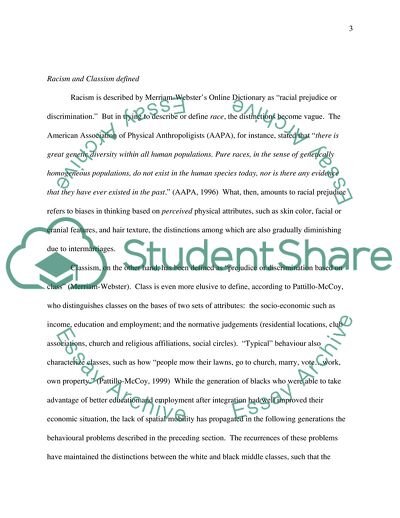
- Home
- Free Samples
- Premium Essays
- Editing Services
- Extra Tools
- Essay Writing Help
- About Us
- Studentshare
- Subjects
- Miscellaneous
- African American Experience
African American Experience - Essay Example

- Subject: Miscellaneous
- Type: Essay
- Level: Undergraduate
- Pages: 4 (1000 words)
- Downloads: 0
- Author: smuller
Extract of sample "African American Experience"
The community chosen is a far cry from the inner-city dwelling of poor blacks. With a population of twelve thousand residents, 95 percent African American, the neighborhood’s average income is thirty percent higher than the comparable figure for Chicago. Seven out of ten residents own their own homes. However, twelve percent of Groveland’s families are within the poverty level, and a similar proportion is unemployed. The author describes Groveland as a “kind of buffer between core black poverty areas and whites,” situating it as a middle class African American neighbourhood the defining characteristics of which are far from defined.
In her description of Groveland residents, it is apparent that the twin phenomena of racism and intra-race classism thrive among the well-to-do blacks in their dealings with fellow blacks. This paper will examine these themes as they are depicted in Black Picket Fences and other works by Pattillo-McCoy. Racism is described by Merriam-Webster’s Online Dictionary as “racial prejudice or discrimination.” But in trying to describe or define race, the distinctions become vague. The American Association of Physical Anthropoligists (AAPA), for instance, stated that “there is great genetic diversity within all human populations.
Pure races, in the sense of genetically homogeneous populations, do not exist in the human species today, nor is there any evidence that they have ever existed in the past.” (AAPA, 1996) What, then, amounts to racial prejudice refers to biases in thinking based on perceived physical attributes, such as skin color, facial or cranial features, and hair texture, the distinctions among which are also gradually diminishing due to intermarriages. Classism, on the other hand, has been defined as “prejudice or discrimination based on class”
...Download file to see next pages Read More
- TERMS & CONDITIONS
- PRIVACY POLICY
- COOKIES POLICY